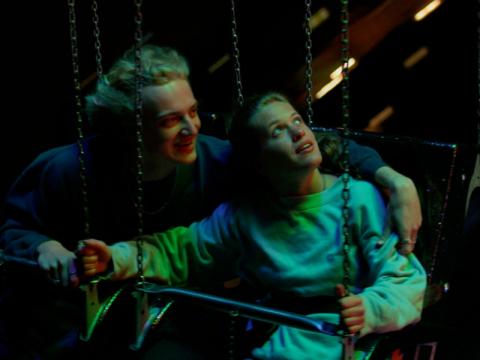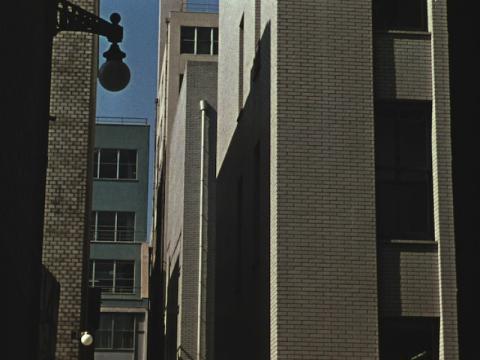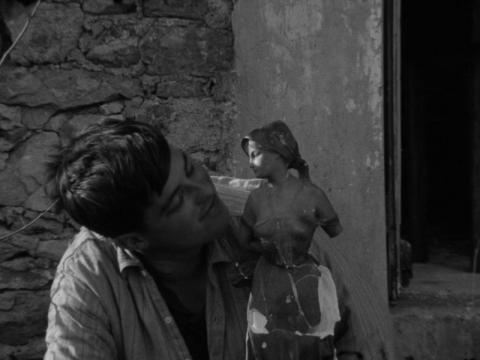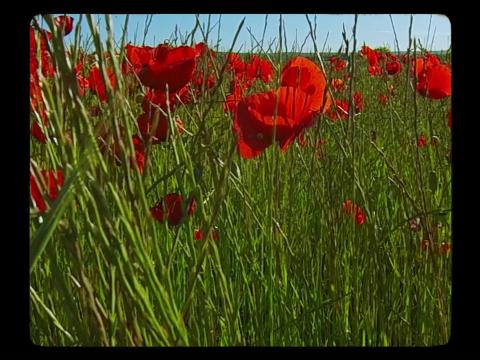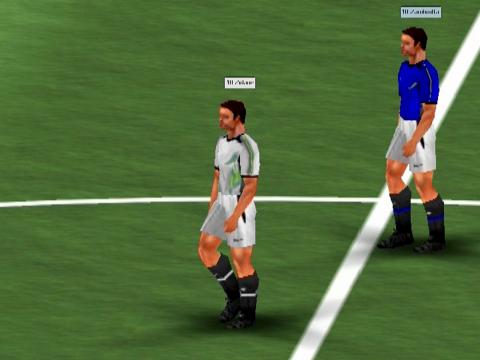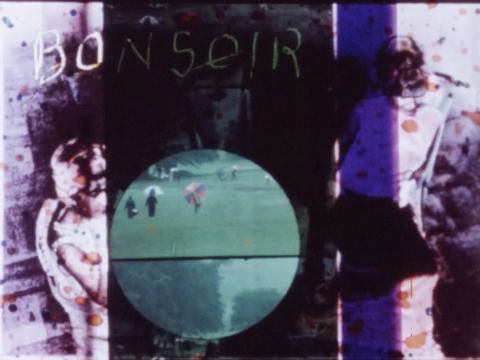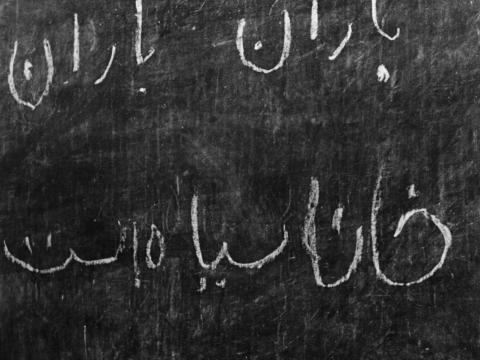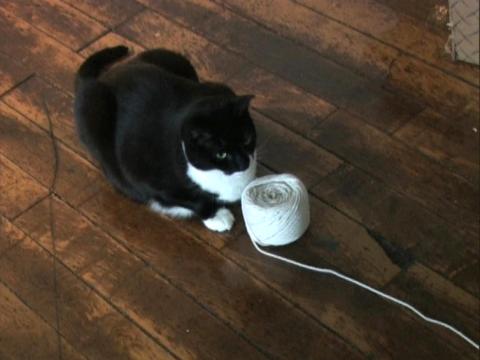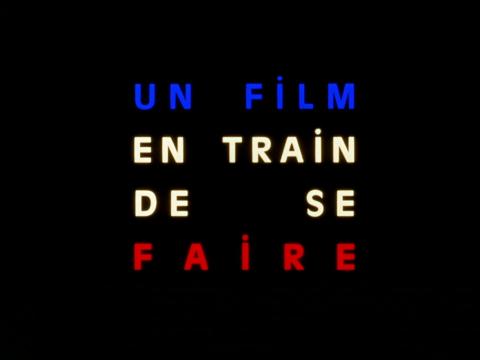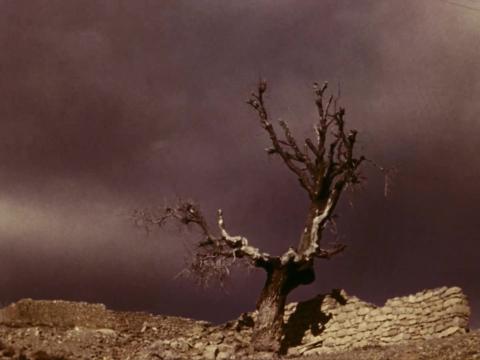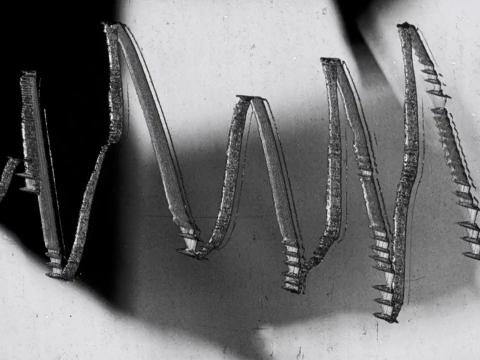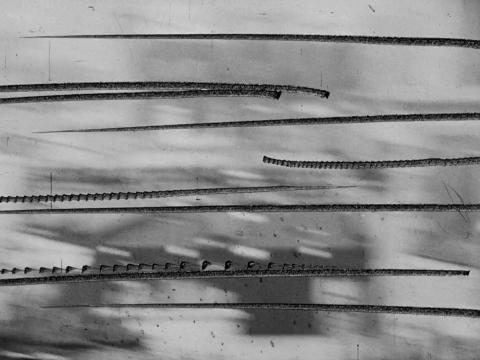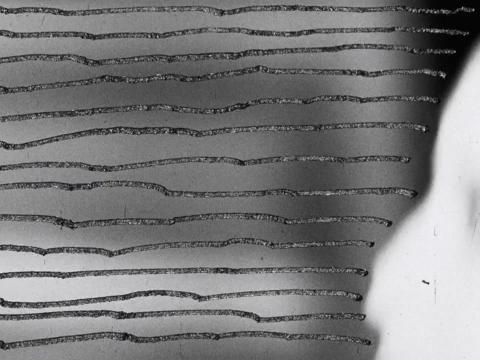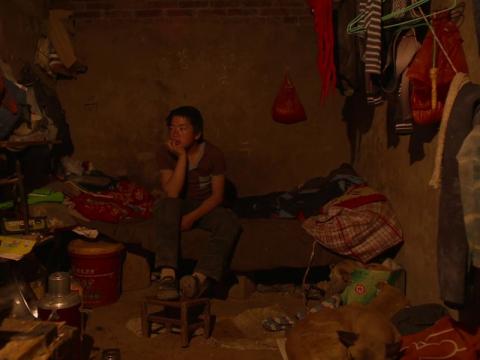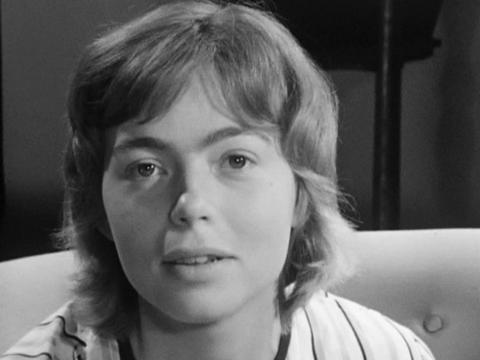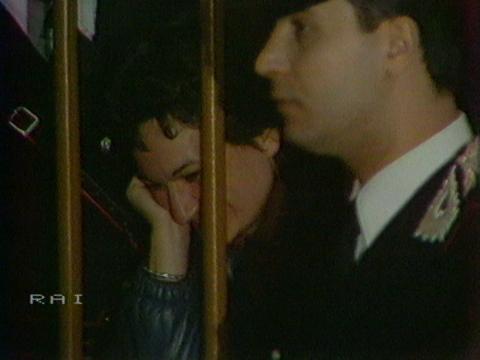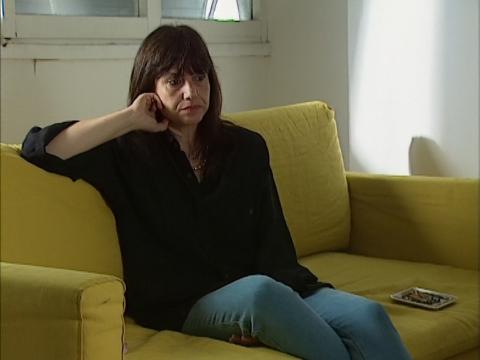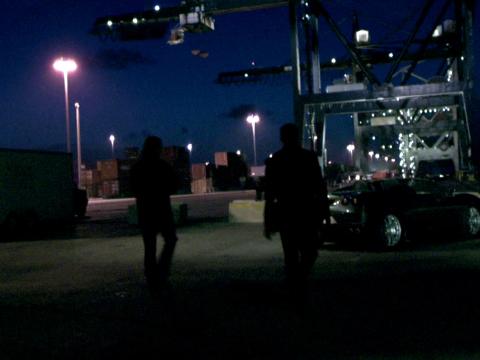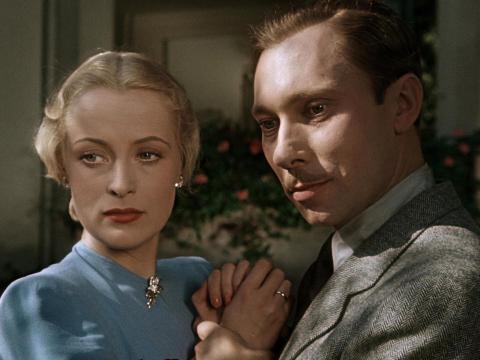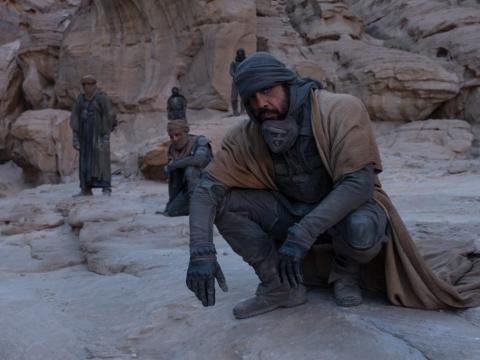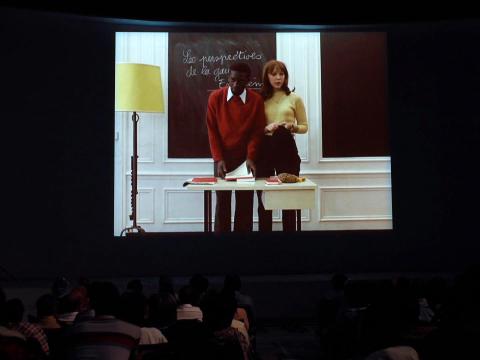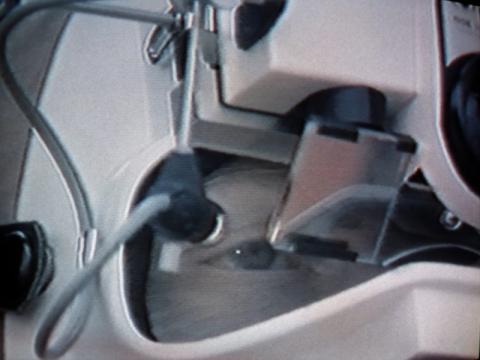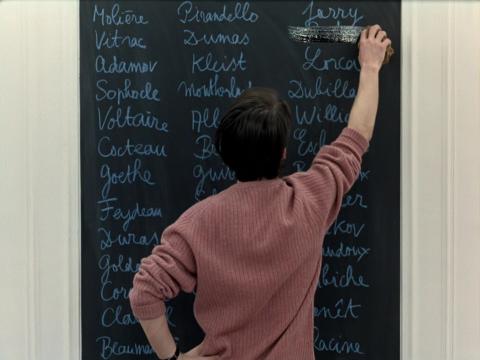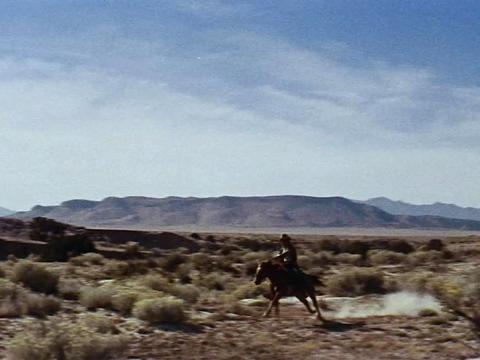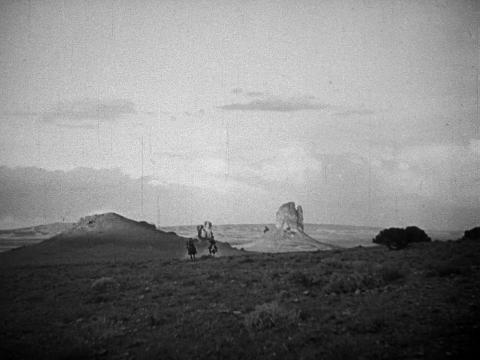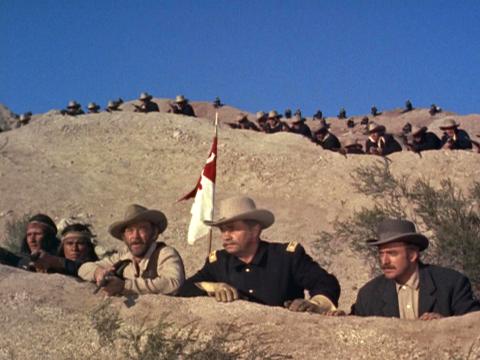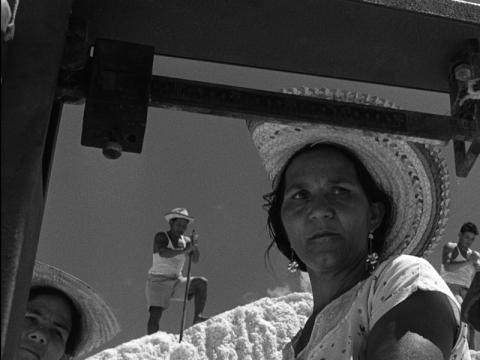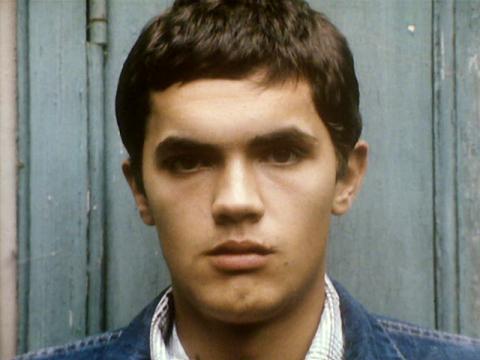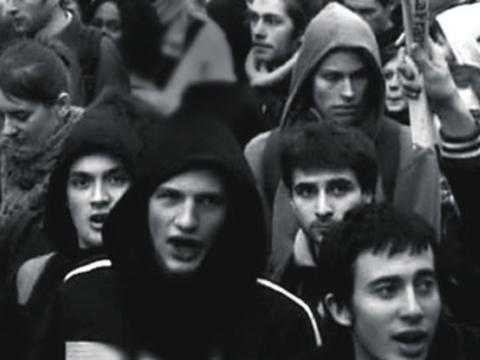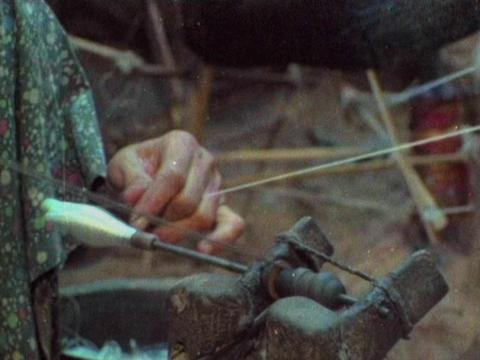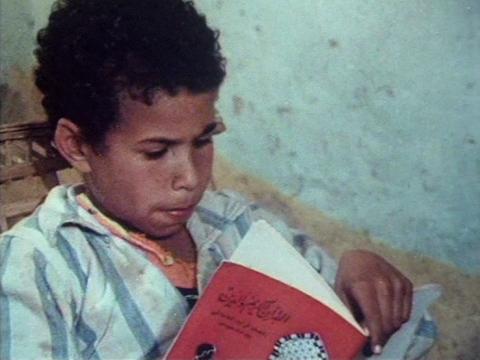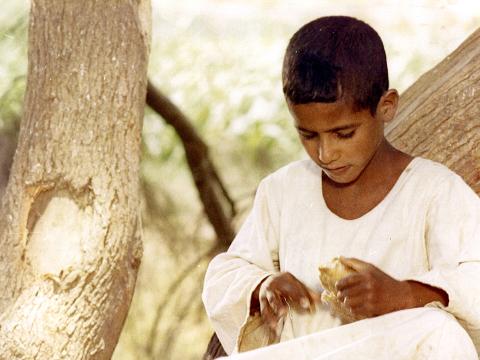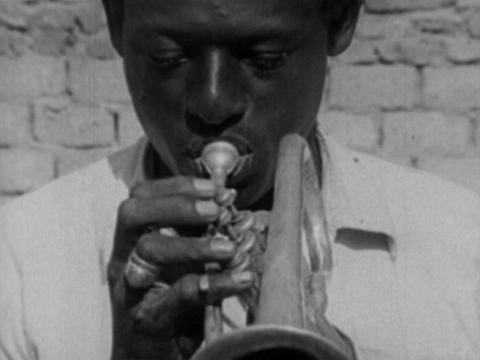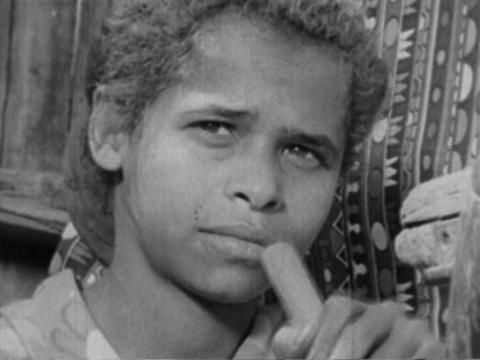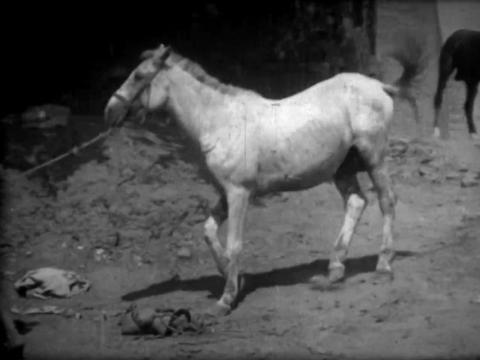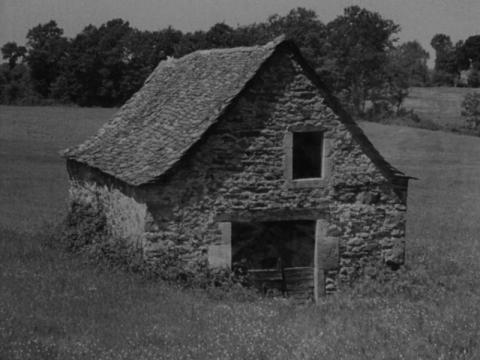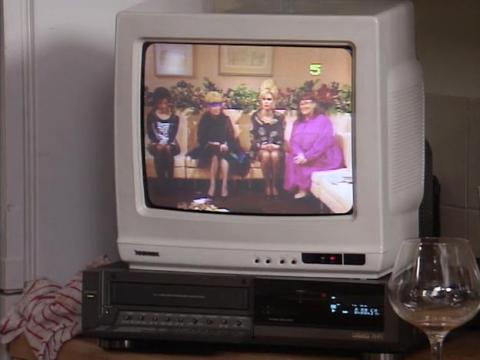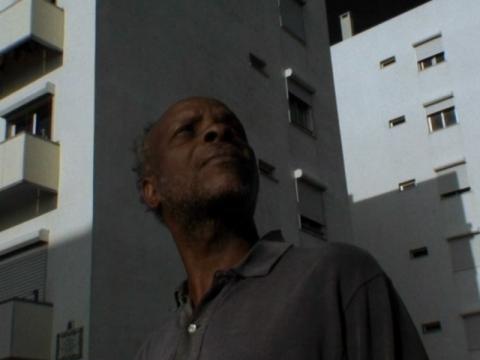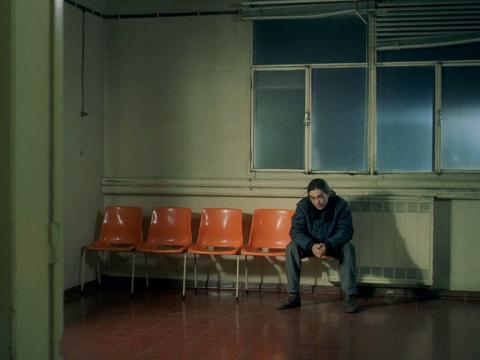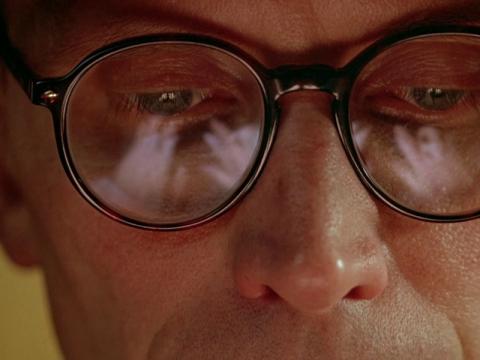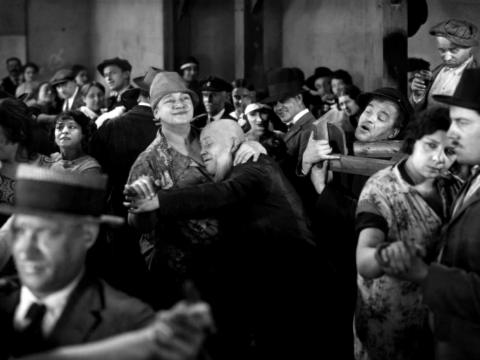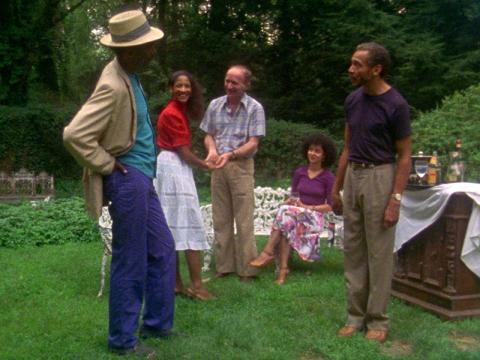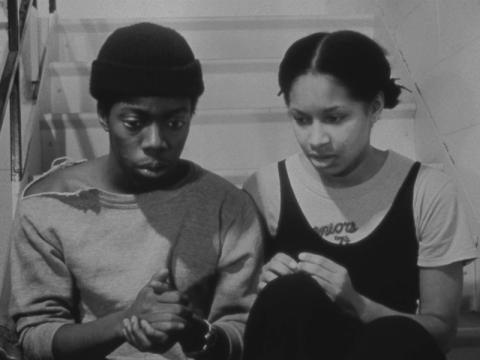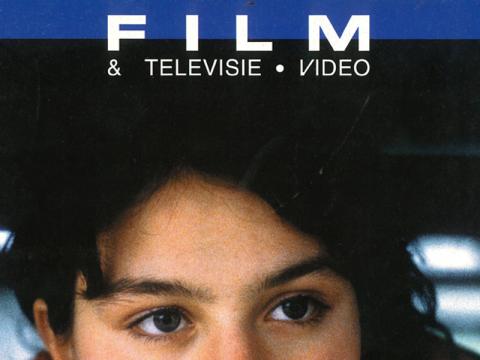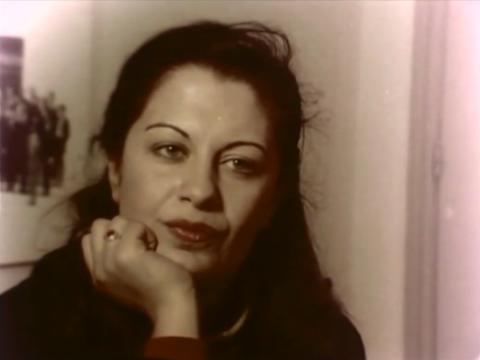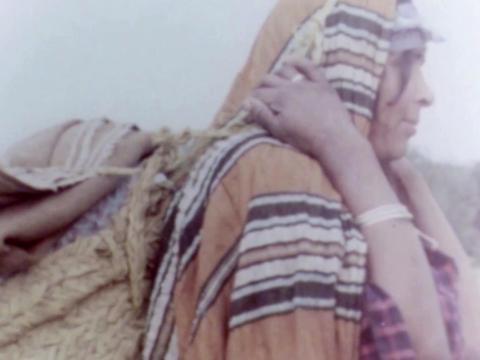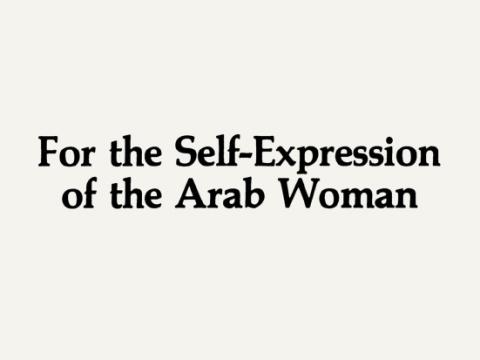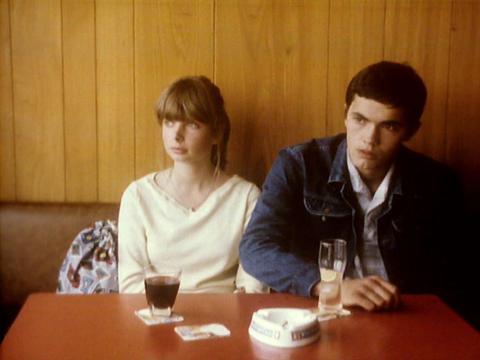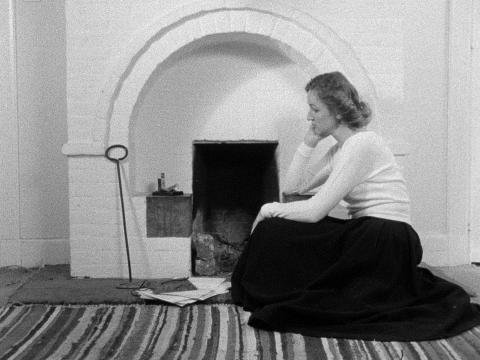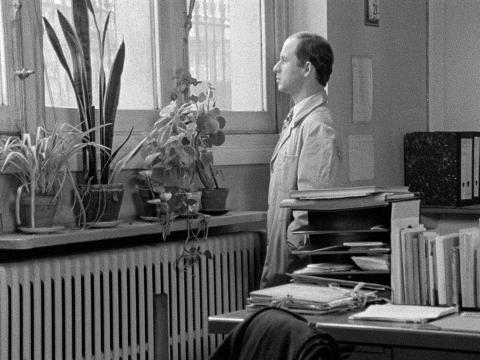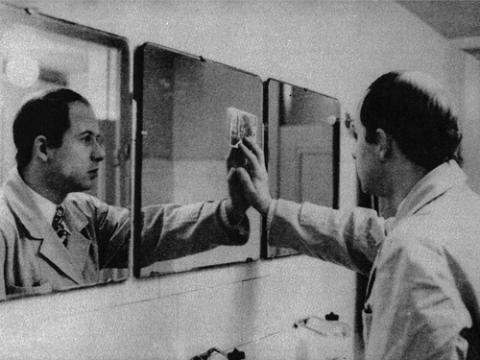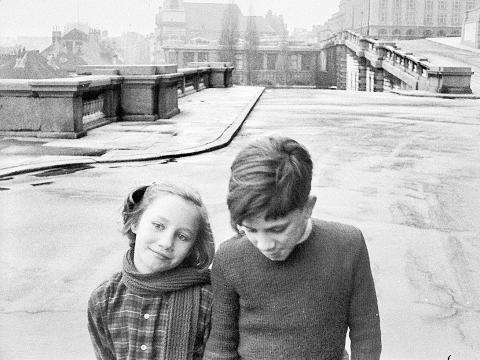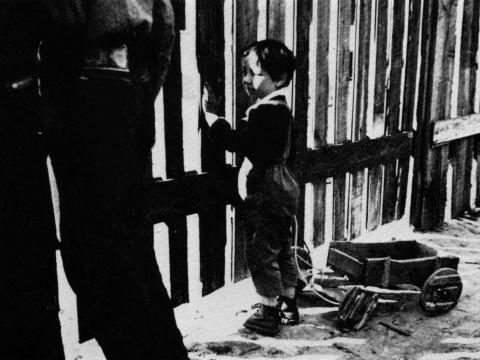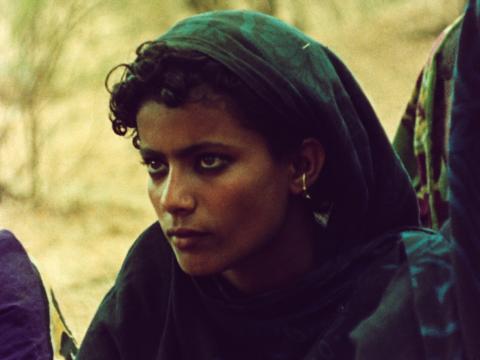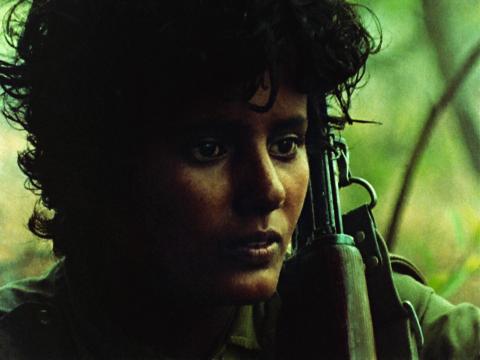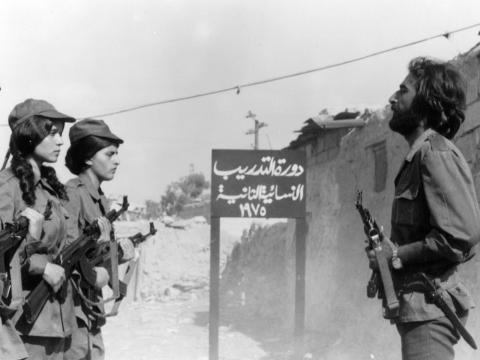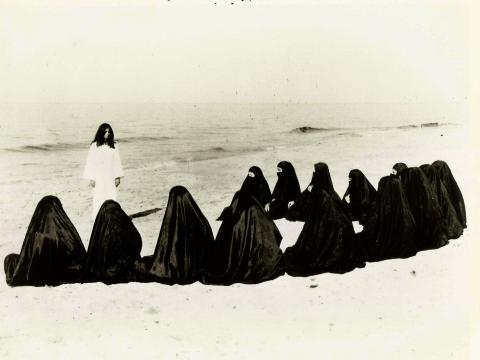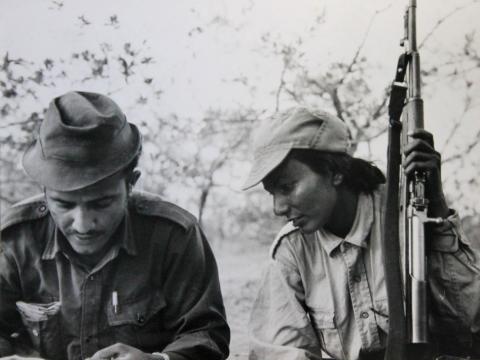Texts
Every Wednesday, Sabzian publishes texts on cinema in Dutch, English or French.Chaque mercredi, Sabzian publie des textes sur le cinéma en néerlandais, en anglais ou en français.Elke woensdag publiceert Sabzian teksten over cinema in het Nederlands, Engels of Frans.
Conversations about Kind Hearts
Gerard-Jan Claes and Olivia Rochette’s new, long documentary, Kind Hearts, follows Billie and Lucas, a young couple from Brussels. Once again, connection through exchange is central. (...) Exchanging views is a dynamic process for them in which observation is central. With great attention and dedication to detail, they capture the adolescent lives without wanting to leave their mark on them. In this way, reality unfolds within a carefully composed cinematic space. Rochette: “Films can be very manipulative. We try to make films that offer an open space rather than a trajectory with clear reference points for emotions or interpretations.”
Gesprekken over Kind Hearts
Gerard-Jan Claes’ en Olivia Rochettes nieuwe lange documentaire Kind Hearts volgt Billie en Lucas, een jong Brussels koppel. Ook hier staat verbinding door uitwisseling centraal. (...) Met elkaar van gedachten wisselen is bij hen een dynamisch proces waarbij observatie centraal staat. Met een grote aandacht en toewijding voor detail wordt het leven van jongeren vastgelegd, zonder er een stempel op te willen drukken. Zo ontplooit de realiteit zich binnen een zorgvuldig gecomponeerde filmische ruimte. Rochette: “Films kunnen heel sturend zijn. Wij proberen films te maken die een open ruimte bieden in plaats van een parcours met duidelijke referentiepunten voor emoties of interpretaties.”
In the coming months, Sabzian will publish a dozen new translations of the work of the German film critic Frieda Grafe, the “queen of German film criticism”. Frieda Grafe: “Ozu is a Zen filmmaker who, in the position of the one who looks and waits, does not want to change the world, but makes himself flat and indifferent like a surface of water, ready for the impressions of the world. When filming, the camera is always a fraction off from his gaze: the space gives a fragmented impression.”
“When it comes to men and women, I feel like I’m honest, and I think that both worlds need to collide or to circumvent each other in order to try and live together.”
Een ingang tot de cinema en het denken van Fernand Deligny
Deze film [Le moindre geste] – weerbarstig toevalsdocument, ruwe parel – lijkt te ontglippen aan elke poging tot categorisering. Hetzelfde zou je kunnen zeggen van de initiatiefnemer, Fernand Deligny (1913-1996). Deze Franse pedagoog, die een leven lang werkte met delinquente, psychisch kwetsbare en mentaal beperkte kinderen en jongeren, valt evengoed schrijver, poëet, filosoof, cineast, … te noemen. Zijn nalatenschap bevat allerlei artefacten: essays, verhalen, scenario’s, toneelstukken, sprookjes, brieven en cartografische tekeningen. Le moindre geste is de eerste van vier films die hij realiseerde in nauwe samenwerking met een wisselende entourage van medewerkers.
Zéro de conduite and L’Atalante by Jean Vigo
Vigo’s films belong to surrealism. Not the Breton school with its suridealism, its amour fou and, for all that, its paternalism. Vigo is one of the “enemies from within”, Bataille, Artaud, life above form, eroticism, the hollowed-out subject. The destruction of the social superstructure becomes the basis of all revolutionary action.
Projections. Provisionals. Provisions
Previously, images were in the world. Today, it is the world that is swimming in an ocean of images. Our real, material and unique world; woven from and overflowing with real, immaterial, numbered (made of numbers), innumerable images. If one wants to observe contemporary cinema one must place it in the context of this exponentially rising quantitative and qualitative power of images, question the role it has played and still plays.
Provisorische projecties en provisies
Vroeger bevonden beelden zich in de wereld. Vandaag is het de wereld die baadt in een zee van beelden. Onze werkelijke, materiële en unieke wereld; geweven en overlopend van werkelijke, immateriële, genummerde (uit getallen bestaande), ontelbare beelden. De hedendaagse cinema observeren dwingt ons ertoe hem in de context te plaatsen van de exponentieel stijgende kwantitatieve en kwalitatieve macht van beelden en ons af te vragen welke rol cinema hierin heeft gespeeld en nog steeds speelt.
Projections. Provisoires. Provisions
Auparavant, les images étaient dans le monde. Aujourd’hui, c’est le monde qui baigne dans un océan d’images. Notre monde réel, matériel et unique ; tissé et débordé d’images réelles, immatérielles, nombrées (constituées de chiffres), innombrables. Observer le cinéma contemporain oblige à inscrire celui-ci dans le contexte de cette exponentielle montée en puissance quantitative et qualitative des images, à s’interroger sur le rôle qu’il y a joué et joue encore.
Annexe du State of Cinema 2021
Décaméron électronique, La Loupe constitua l’une des plus généreuses, prodigues, désintéressées, efficaces des expériences collectives de cinéphilie, conduite au cours du premier enfermement pandémique généralisé. Pendant 17 mois (mars 2020-12 juillet 2021), La Loupe permit à des milliers de personnes de par le monde (jusqu’à 16 000) d’échanger fichiers de films non commercialisés, textes, idées, informations et suggestions dans un esprit de découverte effervescent. A l'occasion de son State of Cinema, Nicole Brenez ajoute en annexe cette proposition de Luc Vialle : « Bonsoir les loupistes, je vous propose en guise d’anniversaire de La loupe bien en retard un post sur le sexe, les sexualités et genres au cinéma ainsi que la représentation des hommes, des femmes et des Queers. »
A.I at War is not a war film as I have made them in the past. I’m not looking to film the battle so much as the symbol of destruction and devastation. For me, the apocalyptic atmosphere is a metaphor for our humanity today.
A.I. at War n’est pas un film de guerre comme j’ai pu en tourner. Je ne cherche pas tant à filmer la bataille que le symbole de la destruction et de la dévastation. Pour moi, l’atmosphère apocalyptique est une métaphore de notre humanité actuelle.
Harun Farocki, in all his works, elaborates and un folds an intensive and meditated form of encounter that we have named “visual study”. What is visual study? It is a matter of a frontal encounter, a face-to-face encounter between an existing image and a figurative project dedicated to observing It – in other words, a study of the image by means of the image itself.
The New Exigencies: For a Republic of Images
I wish to question what could be an internationalism for today, in the field of cinema – a critical internationalism that defies the powers of state, nation, administration and global economy. Almost all the examples I will cite are provided by filmmakers who are trying to help, through images, people other than their own. Thanks to the films themselves, it seems possible to consider, even very briefly, new proposals concerning the conception of history; the conception of the history of cinema; of an oeuvre; of the filmmaker; of political forms; of curating; and, finally, of spectatorship.
“For It Is the Critical Faculty That Invents Fresh Forms” (Oscar Wilde)
With a few remarkable exceptions (Jean Mitry, Jonathan Rosenbaum, Noel Burch ...), the history of cinema has mainly been recounted from the industry’s point of view. May this contribution to a history of forms help us to escape such a dominant ideology and reconsider the works and the artists from a different perspective. Today the violence of the cultural industry is so cynically triumphant that it is possible to establish a law of inverse proportions between the social visibility of a film and its real eminence.
X+ by Marylène Negro
In 2010, with the full-length film X+, Marylène Negro takes up a new dimension of human experience: the collectivity. “A Picture of Us”. What are the aggregating forces that bring forth this drive – brusque or slow, woven from facts, simplifications and resonances that we call, always approximately, collective history? Unendlessly, the cinema records silhouettes, groups, crowds, masses – fleeting passers-by of a period they are going through, tiny extras of a zeitgeist that carries them along.
The House Is Black by Forugh Farrokhzad
Forugh Farrokhzad has never made a film nor led a team before. But she transforms all of these constraints, of this collective and intimate suffering, into a blaze of intelligence, despair and love in the fire of which a unique visual poem has been forged.
Correspondence Between Jonas Mekas and José Luis Guérin
Between 2010 and 2011, the filmmakers and artists José Luis Guérin and Jonas Mekas exchanged nine video letters as the result of an initiative of Jordi Balló. The result was a feature-length film of infinite tenderness, assembling a personal diary, travelogues and key reflections about images. Existential cinephilia, poetic horizons, artistic kinship, elegiac sensibility, a community of views, radicalness, autonomy, all these things bring together these two “friends in cinema” (as Jonas Mekas puts it), whose respective works are characterised by the renewal of descriptive forms and the challenges of observation.
Nicole Brenez is an essential figure in film criticism and contemporary cinema studies. Her analytical and passionate approach to cinema, emerging from her extraordinary creative freedom, has earned her the respect and admiration of critics all over the world. Her widely followed work has never ceased to highlight the exciting challenges of engaged cinema, the kind that commits to artistic investigation as well as to the urgent social and political issues that concern us all.
Every film by René Vautier constitutes a pamphlet, a shield for the oppressed and the victims of history, a little war machine for justice. And like weapons in an underground cell, these films serve, are donated, exchanged, lent, thrown away, destroyed, lost, or hidden and sometimes forgotten in their hideout for a long time. In this regard, every work by René Vautier constitutes a special case, an episode in probably the most novelistic story in the history of cinema. Full of scars though they might be, these films are of a real beauty, not only in the aesthetic and stylistic sense, but in the sense of a cinema elevated to the plenitude of its necessity and its powers.
Few theorists have been as critical of cinema as T.W. Adorno. Critical in this context implies all of the following: methodical, negative and subtle. … For [Adorno], cinema and popular or popularised music … were emblematic of how works of art had become commodified cultural products. A cultural “commodity” represents simultaneously the means of a confiscation, a mode of corruption, a simulacrum, and a sort of formal joke. … [C]inema, which arose out of techniques of recording and whose primary goal is reproduction organised into an industry, appears from the start as a powerful instrument of domination, propaganda and falsification. Adorno’s achievement consists in his having furnished us with instruments for understanding ideology as much as for defining the concept of art.
Le temps présent du cinéma
J’ai une bonne nouvelle, pour tout le monde : le cinéma est en crise. Et d’une certaine façon c’est à peine une nouvelle, il n’a cessé de l’être depuis qu’il existe. C’est non pas le signal d’un danger pour le futur – le futur est une énigme et il faut beaucoup d’irresponsabilité pour tenter d’en formuler l’hypothèse, d’en prétendre déchiffrer les arcanes – mais plutôt celui d’une sensibilité, sismographique, aux enjeux du présent. Et je pense qu’il n’y a pas d’autre symptôme, plus pertinent, de la vitalité d’un art que sa constante remise en cause selon la constante reformulation de notre monde. La véritable question serait plutôt de savoir si les forces qui transforment le monde sont aussi celles qui transforment les arts, comment les unes se nourrissent des autres, à moins qu’elles ne soient antagonistes.
Cinemaul la timpul prezent
Am o veste bună pentru toată lumea: cinemaul se află în criză. Aceasta nici nu este o noutate: cinemaul n-a încetat să fie în criză de când există pe lume. Nu este semnalul unui pericol pentru viitor – viitorul este o enigmă și e nevoie de multă iresponsabilitate pentru a încerca să formulăm ipoteze pe marginea lui, să pretindem că-i descifrăm arcanele –, ci mai degrabă semnalul unei sensibilități seismografice față de mizele prezentului. Și cred că nu există alt simptom mai pertinent al vitalității unei arte decât permanenta sa autoplasare sub lupă, în funcție de permanenta reformulare a lumii noastre. Întrebarea veritabilă ar fi mai degrabă dacă forțele care transformă lumea sunt aceleași care transformă și artele, sau, în caz că sunt două seturi diferite de forțe, cum se hrănesc unele din altele, sau dacă nu cumva sunt antagonice.
Filmens vara 2020
Jag har en god nyhet för oss alla – filmen är i kris. Och på ett sätt är det inte ens en nyhet, för aldrig under sin existens har den upphört att vara det. Det är inte heller signalen för en framtida fara – för framtiden är en gåta som det krävs ett stort mått av oansvarighet för att formulera en hypotes om, påstå sig kapabel att tyda hemligheterna till – utan mer en seismografisk känslighet för vad som står på spel i nutiden. Jag tänker att det finns inget annat eller mer träffande symptom på livskraften i en konstart, än dess konstanta ifrågasättande av sig själv, utifrån en konstant omformulering av världen. Den verkliga frågan är att ta reda på om krafterna som förändrar världen är desamma som förändrar konsterna, hur dessa befruktar varandra, ifall de nu inte är varandras motsatser.
Prítomnosť filmu
Mám pre všetkých dobrú správu: film je v kríze. V istom zmysle to nie je žiadna novinka, lebo v nej neprestal byť, odkedy existuje. Nejde pritom o signál nebezpečenstva pre budúcnosť – budúcnosť je záhada a na formulovanie hypotéz o nej či na predstieranie, že vieme rozlúštiť jej tajomstvá, treba veľkú dávku nezodpovednosti –, ale skôr signál až seizmografickej citlivosti na to, čo sa práve deje. A domnievam sa, že neexistuje iný, presnejší symptóm životaschopnosti nejakého umenia, než jeho nepretržité sebaspochybňovanie na základe nepretržitých reformulácií nášho sveta. Skutočnou otázkou je skôr to, či sú sily, ktoré premieňajú náš svet, zároveň silami, ktoré premieňajú aj umenie, a ako sa jedny sýtia druhými, ak náhodou nestoja proti sebe.
Filmens nuværende tilstand
Jeg har en god nyhed til jer allesammen: Filmkunsten er i krise. Og på en måde er det slet ingen nyhed, for filmkunsten har altid været i krise, lige siden den blev til. Det er heller intet varsel om nogen fremtidig fare – fremtiden er et mysterium, og det kræver megen uansvarlighed at gøre sig nogle formodninger om den, at foregive at kunne tyde dens hemmeligheder – men snarere et udtryk for en seismografisk sensibilitet over for nutidens udfordringer. Og jeg tror ikke, at der findes et andet, mere sikkert tegn på en kunstforms levedygtighed end dens stadige evne til at drage sit eget eksistensgrundlag i tvivl som følge af verdens konstante forandring. Det virkelige spørgsmål bliver således, om de kræfter, der forandrer verden, også er dem, der forandrer kunsten, og hvordan de i så fald nærer hinanden, forudsat de ikke er modsætninger.
Il tempo presente del cinema
Chi pensa oggi il cinema, da quale punto di vista e secondo quali valori? E cosa pensa il cinema di se stesso? In nome di quale etica e di quali principi? Due ordini di domande molto diversi e le cui risposte sembrano essersi frammentate - soprattutto su internet - oltre che molto difficili da organizzare con coerenza.
A Conversation with Wang Bing
In 2018, Wang Bing stayed in Ghent as an “Artist in Focus” in the context of the Courtisane film festival. In the margins of the festival, students and former students of the KASK School of Arts Ghent invited Wang Bing to talk about filmmaking and to cook noodle soup with dumplings together. The director kindly agreed. The conversation that followed was shaped and guided by film fragments shown in between the questions. (...) The following text is an edited transcription of a part of this conversation and deals with filmmaking from the position of the filmmaker.
In 2006, Michael Mann made his ninth film. Miami Vice, a dark fresco devoted to the lives of two undercover agents, depicts in violent detail the effects of the globalisation of crime and the collusion between politics and economics, indeed the absorption of one by the other. It is Mann at his artistic peak, occupying a privileged position in Hollywood: both respected by the “milieu” and a valued asset of the industry, he once again demonstrates his ability to bend the logic of the blockbuster (Miami Vice being puffed up as such) to a personal universe to the extent that we sometimes have the impression of a large-scale misappropriation of funds (the film cost more than $150 million) for the benefit of a radical work that does full justice to the formal and stylistic ambitions of its maker.
In 2006 regisseert Michael Mann zijn negende film. Miami Vice, een duister fresco over het leven van twee undercoveragenten, geeft in gewelddadig detail de gevolgen weer van de mondialisering van de criminaliteit en de collusie tussen politiek en economie, of zelfs het opgaan van het ene in het andere. Mann is op dat moment op het toppunt van zijn artistieke kunnen en bekleedt een bevoorrechte positie in Hollywood: als gerespecteerd figuur in het “milieu” en vaste waarde binnen de industrie demonstreert hij eens te meer zijn vermogen om de logica van de blockbuster (en dat is hoe Miami Vice wordt aangeprezen) om te buigen tot een persoonlijk universum, zodat we soms zelfs de indruk krijgen dat het hier om een grootschalige verduistering van fondsen gaat (de film kostte meer dan 150 miljoen dollar) ten voordele van een radicaal werk dat geen enkele toegeving doet aan de vormelijke en stilistische ambities van zijn maker.
Twee weken geleden overleed de Belgische producer, regisseur, televisiepionier en presentatrice Annie Declerck (1934-2021). In 1997 spraken Marianne Van Kerkhoven en Pascal Gielen met Annie Declerck voor het theatertijdschrift Etcetera. Vier decennia lang heeft zij (theater)kunstenaars geïnterviewd en hun werk gefilmd, eerst voor het NIR, dan de BRT en nog later de BRTN. Zo groeide een indrukwekkend beeldarchief dat ons in het buitenland wordt benijd. Zal de ‘VRT’ het belang van dat archief erkennen? Kan er nog verder beknibbeld worden op de culturele berichtgeving bij de openbare omroep?
Loredana Bianconi Introduces Her Film
In Italy, in the mid-seventies, Adriana, Barbara, Nadia and Susanna were 20 years old when they decided to join the Red Brigades, often seen as the largest communist terrorist organization in post-war Italy. After having returned after many years in prison, filmmaker Loredana Bianconi films these four women as they try, each one of them, to recount their own experiences. In Do You Remember Revolution (1997) they speak about the political reasons which initially sustained them, the conflicts, the doubts, and the moments of being torn apart which market out their lives as women caught up in the vortex of war. Bianconi: “A journey that leads to the condemnation of armed struggle and the pain caused by the destruction of lives – the lives of victims and their own.”
Loredana Bianconi introduit son film
En Italie, au milieu des années 70, Adriana, Barbara, Nadia et Susanna ont 20 ans quand elles décident d’entrer dans la lutte armée, de quitter leur vie sociale et leur famille pour faire de la révolution le centre et le but de leur existence. Elles rejoignent les Brigades rouges, considérées comme la plus grande organisation terroriste communiste d’après-guerre en Italie, et y deviennent des personnages clés. Après de longues années de prison, la réalisatrice Loredana Bianconi filment les quatre femmes alors qu’ils essayent de raconter chacune leur propre expérience. Dans Do You Remember Revolution (1997), elles parlent des raisons politiques qui les ont d’abord soutenues, des conflits, des doutes, des déchirures qui ont marqué leur vie de femme prise dans le tourbillon de la guerre. Bianconi : Un parcours qui débouche sur la condamnation de la lutte armée et sur la douleur due à la destruction de vies : celle des victimes et la leur.
This is not one of the films I am used to. This one has no subject but rather an experience talked about by four collocutors. What we have in front of us are, simply, the answers: four women activists and one more – the one with the camera, asking questions. The difference between this and the other films I’ve seen becomes visible especially when we compare this art piece to other motion picture films which deal with the same topic.
Interview with Dion Beebe, cinematographer of Miami Vice
Michael Mann was one of the first filmmakers working in Hollywood to embrace the digital. After earlier experiments with HD in Collateral (2004) and Ali (2001), Mann resolutely opts for the digital format in his 2006 Miami Vice. In this interview, Miami Vice’s cinematographer Dion Beebe explains that the choice of digital came not from practical concerns but through an experimental search, guided by Mann’s intent of the film. The interview bears witness to this turning point in film history where digital cinema still had to come to terms with itself, still had to start believing in its own possibilities.
Veit Harlans Opfergang
In juli 1943 noteert de propagandachef van de nationaal-socialistische partij Joseph Goebbels in zijn dagboek over de film Opfergang van Veit Harlan: “Buitengewoon goed uitgevoerd qua kleur. Jammer genoeg is het verhaal, zoals dat van Immensee, een beetje te zwaar aangezet. (...) Hij begeeft zich op een pad dat niet veel succes lijkt te beloven. Hij moet terug naar de realiteit gebracht worden.” Als er ooit iemand alle zin voor realiteit kwijt was, is het wel Goebbels, om nog maar te zwijgen over zijn vriend Hitler, maar hier had Goebbels een punt. Opfergang heeft inderdaad iets delirants en daar dragen de schwärmerische koren zeker toe bij.
The western used to be the secret garden of male imagination. Access to it has been closed off, the paradise parceled out, its inhabitants dispossessed. Next up are “the men who like technology”, but cowboys like horses, landscapes, showdowns. For this, freedom is the condition, reward and punishment.
In de jaren zestig en zeventig publiceerde de Belgische auteur, criticus en filmmaker Eric de Kuyper over film in Streven. Uit deze bijzondere collectie teksten herpubliceert Sabzian een aantal markante teksten voorzien van een nieuw commentaar door De Kuyper. De Kuyper: “Au hasard Balthazar bespeelt een bijna onmogelijke spagaat tussen het al te evidente betekenisvolle (de allegorie) en het omgekeerde ervan: het betekenisloze. Iets onvatbaars, hoewel het op de meest concrete manier aanwezig is: in beelden.”
The desert aesthetic in question recurs across Villeneuve's oeuvre, from Blade Runner to Arrival, but it ultimately refers to one of his main sources of inspiration: the ‘Dune’ series written by American science fiction author Frank Herbert, which began to dominate the American West Coast and then took the alternative book circuit by storm in the late 1970s. For years, the director dreamed of bringing Herbert to the big screen, with enough financial clout and logistical support – an arsenal only a major studio could offer him. In the autumn of 2021, after some obligatory COVID delays, the day came: a childhood dream come true.
De esthetiek van de woestijn dook al meermaals op in Villeneuves oeuvre, van Blade Runner tot Arrival, maar verwijst uiteindelijk naar een van zijn voornaamste inspiratiebronnen: de Dune-reeks van de Amerikaanse sciencefictionauteur Frank Herbert, die eind jaren zeventig eerst de Amerikaanse westkust en daarna het alternatieve boekencircuit begon te domineren. Al jaren droomde de regisseur ervan om Herbert te verfilmen met genoeg financiële slagkracht en logistieke ondersteuning – een arsenaal dat alleen een grote studio hem zou kunnen bieden. In het najaar van 2021, na de obligate COVID-vertragingen, was het zover: een jeugddroom ging in vervulling.
Omtrent Juste un mouvement
Het speelfilmdebuut van Vincent Meessen opent op de campus van de Universiteit van Nanterre, schijnbaar bezet door Godard. Het is een bricolage van de Brusselse kunstenaar-filmmaker. Hij lijmt buitenopnames van het schoolterrein en de naburige metrohalte aan interieurshots gemaakt in het plaatselijke Théâtre des Amandiers toen Godard er eind 2019 een tentoonstellingsparcours bouwde rond zijn meest recente film, Livre d’images. Een zwarte man met camera speelt min of meer voor gids. Met hem kijken we in verschillende ruimtes mee naar fragmenten uit verschillende onbenoemde filmwerken terwijl de Franse meester in al evenveel ongelabelde audiosnippers orakelt over le cinéma.
Farocki’s scope was broad. There was a lot of ground covered and many issues explored in the trajectory from early 16-millimeter films like Die Worte des Vorsitzenden [The Words of the Chairman] (1967), which protests the shah of Iran’s official visit to Berlin, to his last multiscreen sculptural installation, Parallel I–IV (2012–14), which examines the development of the virtual world of video games and their relationship to space. Indeed, surveying Farocki’s oeuvre serves as a revealing case study of the history of experimental filmmaking in Europe in the past half-century.
Gedachten bij Harun Farocki’s Bilder der Welt und Inschrift des Krieges
Bilder der Welt und Inschrift des Krieges is een sleutelwerk uit het oeuvre van Harun Farocki en werd oorspronkelijk opgestart als een project over de geschiedenis van de arbeid. Maar onvermijdelijk lijk je dan uit te komen bij oorlog. De film toont hoe beide geschiedenissen met elkaar zijn verstrengeld, elkaar voortstuwen en teren op dezelfde technologische vooruitgang.
Interview met Nina de Vroome over Globes
De filmpraktijk is voor De Vroome zowel een alibi voor ontmoetingen als een levensmodus. Het is maar via de camera en de microfoon, via vormen, dat de wereld, een wereld, lijkt te ontstaan. In haar nieuwe film Globes bekijken we die wereld vanuit het standpunt van bijen. De Vroome: “In de kleuren van de raten zie je het landschap weerspiegeld. Iedere cel in de raat heeft een andere kleur, door de pollen van verschillende bloemen. De raat biedt een beeld van het landschap, van de wereld rondom. Dat is één manier van kijken die de bijen aanreiken. De film is een verzameling van visies op het landschap, de cultuur en de geschiedenis die samen een soort lappendeken vormen.”
Omtrent La chinoise
Een van mijn favoriete stukken over een van mijn favoriete filmmakers heet simpelweg Jean-Luc Godard. De Amerikaanse schilder, filmcriticus en auteur Manny Farber schreef het in 1968. Ik las het ongeveer dertig jaar na datum in Negative Space, de bundeling van zijn beste stukken uit die periode. Sindsdien schiet me bij het bekijken van een film van JLG geregeld de slotzin van het artikel te binnen: “In short, no other film-maker has so consistently made me feel like a stupid ass.” (...) In bevlogen proza laat Farber zich schamper uit over Godards productieve sixties-output, die hij met stijgende ergernis merkbaar op de voet heeft gevolgd en maar wat graag haat. De spreekwoordelijke druppel die aanleiding geeft tot balansopmaak: La chinoise.
André Bazin is sometimes called “the inventor of film criticism”. Entire generations of film critics and filmmakers, especially those associated with the Nouvelle Vague, are indebted to his writings on film. Film opens a “window on the world”, according to Bazin. His writings would also be important for the development of the auteur theory. Bazin: “Let’s face it, westerns aren’t taken seriously! Sure, there is no shortage of intellectuals declaring their love of westerns. One hears plenty of distinguished old gentlemen proclaiming it loudly. But even without looking for the posturing this declaration of faith entails (ask for titles and you will find that these self-proclaimed “western lovers” only see one or two a year!), one can be almost certain that it is based on a misunderstanding.”
André Bazin est parfois appelé « l’inventeur de la critique cinématographique ». Des générations entières de critiques et de cinéastes, notamment ceux associés à la Nouvelle Vague, sont redevables à ses écrits sur le cinéma. Le film ouvre une « fenêtre sur le monde », selon Bazin. Ses écrits sont également importants pour le développement de la politique des auteurs. Bazin : « Avouons-le, le western n’est pas pris au sérieux ! Assurément, il ne manque pas d’intellectuels pour déclarer qu’ils adorent les westerns. On entend de vieux messieurs distingués le proclamer bien haut. Mais sans même chercher ce que peut comporter d’affectation cette profession de foi (exigez des titres et vous verrez que ces prétendus « amateurs de westerns » en voient un ou deux par an !), on peut être quasiment assuré qu’elle est fondée sur des malentendus. »
André Bazin wordt weleens de “uitvinder van de filmkritiek” genoemd. Hele generaties filmcritici en filmmakers, niet in het minst die verbonden met de Nouvelle Vague, zijn schatplichtig aan zijn schrijfsels over film. Film opent een “venster op de wereld”, aldus Bazin. Zijn geschriften zouden ook belangrijk zijn voor de ontwikkeling van de auteurstheorie. Bazin: “Laten we wel wezen, westerns worden niet serieus genomen! Er is uiteraard geen gebrek aan intellectuelen die verklaren dat ze dol zijn op westerns. Men hoort genoeg deftige oude heren het luid verkondigen. Maar zelfs zonder op zoek te gaan naar wat voor aanstellerij deze geloofsbelijdenis inhoudt (vraag naar titels en u zult zien dat deze zogenaamde “westernliefhebbers” er maar één of twee per jaar zien!), kan men er bijna zeker van zijn dat ze op een misverstand berust.”
Notes on Cinema Ritrovato 2021
Just like last year, a coronavirus edition of Bologna’s unsurpassed Cinema Ritrovato festival took place this summer. The festival is unique for its broad focus on the history of film, showing new restorations and recent (re)discoveries rather than new films.
Notities bij Cinema Ritrovato 2021
Net zoals vorig jaar vond deze zomer een corona-editie plaats van het onvolprezen Cinema Ritrovato-festival in Bologna, dat met zijn brede focus op de gehele filmgeschiedenis enig is in zijn soort. Niet zozeer nieuwe films worden er vertoond, als wel nieuwe restauraties en recente (her)ontdekkingen.
Aantekeningen over Witold Gombrowicz en de films van Jan Decorte
In slechts drie jaar tijd ontstond het gehele oeuvre van Jan Decorte (1950) als filmmaker. Hij regisseerde het televisiespel Nature morte (1976), de langspeelfilms Pierre (1976) en Hedda Gabler (1978), en de televisiefilm Gombrowicz: voorvallen, avonturen (1977). Na de voltooiing van deze films maakte Decorte geen films meer; hij had naar eigen zeggen genoeg van productionele rompslomp en filmcritici die zijn werk niet serieus wensten te nemen. (...) Ook de Poolse auteur Witold Gombrowicz (1904-1969), onderwerp van Decortes televisiefilm, kreeg amper bijval van binnen- en buitenlandse critici en werd geregeld gemakzuchtig aan de kant geschoven.
A Model Film
André Bazin is sometimes called “the inventor of film criticism”. Entire generations of film critics and filmmakers, especially those associated with the Nouvelle Vague, are indebted to his writings on film. Film opens a “window on the world”, according to Bazin. His writings would also be important for the development of the auteur theory. Bazin: “Chris Marker’s Sunday in Peking unfortunately lasts just twenty minutes, and the crop of images seems poor compared to Pedrazzini’s. But the image is not limited here to itself. Its value is developed in two supplementary dimensions: the editing and the commentary.”
Een modelfilm
André Bazin wordt weleens de “uitvinder van de filmkritiek” genoemd. Hele generaties filmcritici en filmmakers, niet in het minst die verbonden met de Nouvelle Vague, zijn schatplichtig aan zijn schrijfsels over film. Film opent een “venster op de wereld”, aldus Bazin. Zijn geschriften zouden ook belangrijk zijn voor de ontwikkeling van de auteurstheorie. Bazin: “Chris Markers Dimanche à Pékin duurt helaas maar twintig minuten en de beeldenoogst lijkt magerder dan die van Pedrazzini. Maar het beeld beperkt zich hier niet tot zichzelf. De waarde ervan wordt bepaald door twee extra dimensies: de montage en het commentaar.”
Un film modèle
André Bazin est parfois appelé « l’inventeur de la critique cinématographique ». Des générations entières de critiques et de cinéastes, notamment ceux associés à la Nouvelle Vague, sont redevables à ses écrits sur le cinéma. Le film ouvre une « fenêtre sur le monde », selon Bazin. Ses écrits sont également importants pour le développement de la politique des auteurs. Bazin : « Dimanche à Pékin de Chris Marker ne dure malheureusement que vingt minutes et la moisson d’images paraît mince à côté de celle de Pedrazzini. Mais l’image n’est pas ici limitée à elle-même. Sa valeur se développe dans deux dimensions supplémentaires, celle du montage et celle du commentaire. »
“Alongside his activities as a writer, critic, photographer, scriptwriter, filmmaker, photo editor, media artist and cartoonist/blogger, Chris Marker has recently also begun frequenting Second Life, where his avatar bears the name Sergei Murasaki. Under this guise, Marker consented to a rare online interview, where he advances the notion that he never even considered himself to be a filmmaker. Ja-mais. Furthermore, he thinks the label of ‘multi-media artist’ sounds altogether too contemporary. Rather, Marker prefers to be characterized as an artisanal bricoleur, albeit one who always puts his own unique signature on everything he tinkers with.”
"Naast zijn activiteiten als schrijver, criticus, fotograaf, scenarist, filmmaker, fotoredacteur, mediakunstenaar en cartoonist/blogger frequenteert Chris Marker sinds kort ook Second Life, waar zijn avatar Sergei Murasaki heet. In die gedaante stond Marker een zeldzaam online interview toe, waarin hij stellig poneert dat hij zichzelf nooit als een cineast heeft beschouwd. Ja-mais. Multimediakunstenaar vindt hij dan weer te eigentijds klinken. Hij houdt het liever op een typering als ambachtelijk bricoleur. Maar dan wel een knutselaar die aan alles een eigen signatuur verleent.”
Staring Back brings together about two hundred black-and-white photo portraits produced by Chris Marker from 1952 to 2006. It arose unforeseen (but what route better, given how we believe we’ve come to know him?) from an exchange of letters.
Staring Back verzamelt zowat tweehonderd zwart-witportretten, die Chris Marker tussen 1952 en 2006 maakte. Het ontstond onverwacht naar aanleiding van een briefwisseling (maar is er een betere weg, gezien de manier waarop we denken dat we hem leerden kennen?)
Atteyat Al-Abnoudy, a pioneer of documentary filmmaking, has been making the voices of the poor heard since the 1970s. We meet her when the first Women’s Film Festival is paying tribute to her. (...) Some call her “the poet of the documentary”. Others criticize her for portraying the poor, the bratty children, the run-down places and the abject sides of reality. Likewise, Egyptian television, the only means of broadcasting her work, asks her to disclaim her inventories of misery in order to benefit from funding. She retorts to her detractors: “You must know how to reveal reality with its dark and luminous sides, without hiding an admiration for the total commitment of the beings whose lives meet History.”
Atteyat Al-Abnoudy’s definition of documentaries is simple and all-encompassing: “No script, no actors, no direction. The cameraman follows the subject.” (...) “What I want,” says Al-Abnoudy, leaning forward to make the point, “is a Déscription de l’Egypte on film.” Layers and layers of thick description that would make Clifford Geertz happy, testimonies from people rarely heard from, images of daily struggles to survive, dreams deferred but not forgotten.
A Conversation with Atteyat Al-Abnoudy
We listen to Atteyat Al-Abnoudy speak in a loud voice about her vision for art, life and reality; and we get to know her inimitable, riotous character in return. Atteyat Al-Abnoudy: “I don’t care for the prizes as much as I care for my films to be shown in my own country, because I am offering pure Egyptian cinema to the Egyptian people, and I am addressing the existence of the authentic Egyptian human. Regardless of how many prizes I win around the world, their entire sum is not as worthy as one single glance of a pair of Egyptian eyes that give my films their glory and true worth.”
A Conversation with Atteyat Al-Abnoudy
“I look at life in a poetic way. I love to live and I think that poor people in my country are all doing their best to work and to create life. I try in all my films to convey this love of life, even if the people live in very poor conditions. I treat them with great respect. I love to see their faces on the screen. I come from the working class, but film is a middle-class medium, so you have to be strong in order to maintain your relationship to your class. Otherwise you are lost.”
A Conversation with Atteyat Al-Abnoudy
Atteyat Al-Abnoudy, a young Egyptian filmmaker, has won the Grand Prix du film documentaire in Grenoble and the International Federation of Film Critics prize for Horse of Mud. And for her film The Sad Song of Touha, she has won the Novais Teixeira prize: a prize founded in memory of our colleague who died last year and who was much loved by French critics. We met Atteyat Al-Abnoudy before she was awarded these important prizes, important for the direction she wishes to give to her work. Al-Abnoudy: “When I start a film, I don’t think about its form. When I became friends with the people in the factory, the only way for me as a filmmaker to express my feelings for them was to make a film.”
A Conversation with Atteyat Al-Abnoudy
“I don’t want to make films because of some beautiful subject or because there’s something fascinating me in the colours or anything like that. It’s at least 50 years now making films in Egypt and always we see on the screen lovely houses and lovely hills, the decor and other fantastic things for us. But the poor people and the working class are not on the screen, when they have the right to be.”
Je savais déjà qu’on ne fait pas tourner comme ça du jour au lendemain des gars qui ne sont pas des comédiens. Surtout quand tu veux faire un long métrage. Et là, je me jetais dans un long métrage parlant. Des copains m’avaient dit : « Méfie-toi ! » Je leur répondais : « Merde ! Flaherty a bien tourné Nanouk, il a bien tourné Moana ! » « Ah oui, d’accord, mais c’est du muet ! Toi, tes paysans, quand ils vont ouvrir la bouche, tu vas voir, ce sera la catastrophe. » J’ai quand même tenu bon. Bien sûr, on ne peut pas leur faire jouer Le Cid ou Hamlet... Tu es obligé de leur faire jouer une chose qui leur tient aux tripes.
Reflets d’une polémique
Le film à peine terminé, commence « l’affaire Farrebique » : le jury de sélection du 1er Festival de Cannes, l’élimine de la compétition [...] « Quelques réserves que l’on puisse faire sur la conception très arbitraire du sujet, écrit Georges Sadoul, Farrebique avait une place marquée au Festival, alors qu’on eût pu refuser même un strapontin à la logorrhée particulièrement incontinente que constituait Un revenant. Mais c’est précisément le dialoguiste de ce film, Henri Jeanson, membre de la commission, qui a batailléé pour le refus de Farrebique, bien qu’il s’en défende : « Farrebique n’a pas été proposé à nos suffrages. Je suis, il est vrai, de ceux qui trouvent ce film ennuyeux. Je ne tiens pas la bouse de vache pour une matière photogénique. J’ai peut-être tort, j’en conviens, mais je proteste contre ceux qui prétendent en toute mauvaise foi que Farrebique a été recalé. »
In the series ‘One Spectator Among Others’ Herman Asselberghs and Gerard-Jan Claes invite various passionate film lovers to elaborate on their viewing practice by email. Filmmakers, artists, critics, researchers, authors, programmers, cinemagoers, TV enthusiasts, Netflixers, YouTubers, torrent users... After the first instalment with Herman Asselberghs, we continue the series with Rebecca Jane Arthur, a Scottish visual artist, living in Brussels. She is co-founder of elephy, a production and distribution platform for film and media art based in Brussels.
In ‘Een kijker onder de anderen’ laten Herman Asselberghs en Gerard-Jan Claes via e-mail allerlei gepassioneerde filmliefhebbers uitvoerig aan het woord over hun kijkpraktijk. Filmmakers, kunstenaars, critici, onderzoekers, auteurs, programmatoren, bioscoopbezoekers, tv-fanaten, netflixers, youtubers, torrentgebruikers,… Na de eerste aflevering met Herman Asselberghs zetten we de reeks voort met Rebecca Jane Arthur, een Schotse beeldend kunstenares die in Brussel woont. Naast haar artistieke praktijk werkt Arthur als producent, schrijver, copy-editor en vertaler. Ze is ook medeoprichter van elephy, een productie- en distributieplatform voor film- en mediakunst gevestigd in Brussel.
In flagrante delicto
In close-up verschijnen achtereenvolgens een penis en schaamhaar, borsten, en opwaartse benen. De eerste beelden uit dit aanstootgevende schimmenspel zijn vrij snel na elkaar gemonteerd. (...) Het ratelende geluid van het pornografische speelgoed roept associaties op met een filmprojector in overdrive. Zo opent Walerian Borowczyks Une collection particulière (1973) met een reflectie op het filmmedium en zijn voyeuristische genoegens.
The Portuguese filmmaker Pedro Costa made his first film, Blood, in 1989. In 1994, Down to Earth followed, which was filmed in Cape Verde. Costa came back from the island with a number of parcels and letters from Cape Verdeans he had met there, addressed to their relatives and friends who had emigrated to Portugal. His task as a postman brought him to Lisbon’s Fontainhas neighbourhood, where many migrants were living at the time. After this first contact with the inhabitants of the neighbourhood, Costa kept returning there, filming Ossos in 1997, the first instalment in a series of films he would make with the inhabitants of Fontainhas. Pedro Costa: “Fontainhas is, indeed, the product of something, of the factories here, of people moving from some northern Scottish village to Sheffield. That is what it’s about.”
De Portugese filmmaker Pedro Costa maakte zijn eerste film Blood in 1989. In 1994 volgde het in Kaapverdië gefilmde Down to Earth. Costa kwam terug van het eiland met pakjes en brieven van Kaapverdianen voor hun familieleden en vrienden die naar Portugal waren geëmigreerd. Zijn taak als postbode bracht hem naar de wijk Fontainhas in Lissabon, waar veel migranten woonden. Na het eerste contact met de bewoners van de wijk ging Costa verschillende keren terug en in 1997 filmde hij er Ossos, de eerste van een reeks films met de bewoners van Fontainhas. Pedro Costa: “Fontainhas is inderdaad het gevolg van iets, van de fabrieken hier, van mensen die van een of ander Noord-Schots dorp naar Sheffield verhuisden. Daar gaat het over.”
De taal is een parasiet
Meer nog dan een vreemde film is Naked Lunch een film die mainstreamfilms vreemd maakt. Er komt immers iets bloot te liggen van de mechanismen die we als normaal beschouwen. We kunnen de parallel trekken met medici die het normale fysieke functioneren trachten te begrijpen door de afwijking, een ziekte, te onderzoeken.
Van 9 juni tot en met 31 augustus wijdt CINEMATEK een tentoonstelling aan Fernand Schirren, de hoofdpianist die stille films begeleidde vanaf de oprichting van het Filmmuseum in 1962 tot 1982. In 1982 hielp Schirren mee aan het samenstellen van een vaste ploeg pianisten die de dagelijkse projecties in CINEMATEK zouden begeleiden, waaronder Jean-Luc Plouvier. Plouvier: “Zonder voorbereiding improviseren op stille films is een bijzondere discipline, sterk te onderscheiden van het schrijven van filmmuziek. De pianist staat niet aan de kant van de regisseur en de monteur, die voorbereid zijn en hun werk meestal verbergen.”
Du 9 juin au 31 août, CINEMATEK consacre une exposition à Fernand Schirren, le pianiste principal à avoir accompagné les films muets de la fondation du Musée du Cinéma en 1962 à 1982. En 1982, Schirren participe à la constitution d’une équipe permanente de pianistes pour accompagner les projections quotidiennes, dont Jean-Luc Plouvier. Plouvier: “L’improvisation sur muets, sans préparation, est un artisanat particulier, à distinguer absolument de l’écriture d’une musique de film. Le pianiste n’est pas situé du côté du réalisateur, dont l’action est préméditée et l’effort généralement dissimulé.”
I think of myself as someone who has an instinctual understanding of what it is to be a minority person. That is someone whose existence is highly marginal in the society and understands it in the gut but will not be dominated by it. Therefore, I refuse all of those labels, such as Black Woman Filmmaker, because I believe in my work as something that can be looked at without labels.
A Conversation with Kathleen Collins Prettyman
“The thing that writing teaches you, which is probably the thing I’ve discovered that I know best about, is the mastery of form. And each discipline is really an exercise in understanding what is allowable in the structure of that particular form. Screenplay writing has curves and you have to write for the curves of the story.”
In order to get at how I think about making a movie at a low budget, I have to be able to give you the theory, the narrative theory, that supports my reasons for making movies. If any of you have seen my work, you know I’m only interested in telling stories, and most of those stories are fairly contemporary. And to some degree they are ahistorical, meaning, though I think that is going to change, that the focus of the work is entirely narrative in orientation.
It would be more than fair to say that in American films, the motif of adventure is one of the favorite story-telling devices. So many films come to mind – from the most banal to the most memorable of the western, detective, and war genre films of the 30’s, 40’s and 50’s to the rash of modern-day science fiction films patterned on the Star Wars or Close Encounters formulas. (...) Two other films stand out in my mind that take the adventure story theme to another level, and therefore deserve a closer look: Charles Lane’s A Place in Time, and Charles Burnett’s Killer Of Sheep.
Het nieuws passeerde bijna geruisloos: eind februari vroeg Filmmagie het faillissement aan, het oudste filmtijdschrift van het land legde finaal de boeken neer. (...) Drie weken geleden lanceerde het VAF een oproep voor projectsubsidies van 65 000 euro voor een opvolger van Filmmagie. Het tijdschrift moet focussen “op onafhankelijke filmkritiek met oog voor enerzijds kwaliteitsfilms met een culturele en maatschappelijke betekenis en anderzijds voor de ontwikkeling van filmcultuur in Vlaanderen en daarbuiten”. Daarbij moeten “achtergrond, kritiek en verdieping hand in hand gaan”.
As the pioneer of female Tunisian filmmakers, Selma Baccar has first and foremost also answered back to men’s representations of women in her own films. From The Awakening (1966) to Fatma 75 (1975), The Dance of Fire (1995) to Flower of Oblivion (2006), the historical detail, contemporary relevance and concern with women in a much wider context have gained her the reputation of the “grande dame” of Tunisian cinema: a feminist activist. Selma Baccar: “As an activist for women’s rights, I have always felt that women are the cornerstone of society in general, and as a child of the age of protests in the 1960s I felt that I could be not only a spokesperson for the Tunisian woman but also an informer and critic of the contemporary atmosphere in Tunisia.”
Interview with Selma Baccar
“The International Women’s Year provided me with the opportunity to make it [Fatma 75]. I figured that, for the first Tunisian film entirely devoted to this subject, I must not resort to fiction but make an analytical work. Through this film, I set about demystifying what is called ‘the miracle of Tunisian women’s emancipation’.”
Interview with Selma Baccar
Selma Baccar’s film opens with a series of portraits of women who have marked the history of Tunisia through the ages. In a theatrical way, Sophonisba, Kahina, Jelajil, and Aziza present themselves to us as the predecessors, through their courageous actions, of this young girl, Fatma, in 1975.
Interview with Selma Baccar
Fatma 75’s approach is quite original. The film is based on essays and histories written on the Tunisian feminist movement, using fiction to make its message accessible to the general public. Selma baccar: “As for my experience as a woman director, I think it was very important for me. My relationship with the crew and the actors was excellent. The shooting of Fatma 75 was “all roses”. On the other hand, in order to obtain the necessary funding for the production of the film, I felt a great mistrust from some of the people in charge, although I had a special card up my sleeve: a film about women made by a woman. But the problem of film production in Tunisia is the same for men and women: it’s negative for both of them.”
“Given this situation, the three of us – a filmmaker, a critic and a technician in the Arab cinema – have decided to establish an ‘Assistance Fund’ for the self-expression of the Arab woman in the cinema. A yearly prize of 10,000 ff (about $2500) will be awarded to the best script for a short film from those proposals submitted by Arab women undertaking their first film.”
Interview with Jan Decorte
“It’s much more enjoyable to watch theatre than to make theatre, and it is much more enjoyable to make films than to watch a film, because film is a much more evolved medium when it comes to the material you are interpreting. Imagine to simply steal someone’s face, their appearance, capturing it at the angle you’re most attracted to, where it moves you, and to try to piece together all that you’ve stolen afterwards during the editing; that you can then fabricate something very moving.”
Interview met Jan Decorte
“Het is veel plezieriger om naar theater te kijken dan om theater te maken, en het is veel plezieriger om film te maken dan naar film te kijken, omdat film een veel meer geëvolueerd medium is wat lezen betreft, wat de lectuur betreft. Dat je gewoon iemand zijn gezicht, zijn voorkomen steelt, inblikt op het ogenblik dat het jou bevalt, ontroert, en dat je bij de montage ziet hoe al die berovingen bij elkaar passen.”
It is an intriguing film because of its original position in the field of Flemish film production. This is not some attempt at a standard technical finish that’s devoid of aesthetic politics. It is a clearly defined boundary, an emphatic style within which the entire film must develop. This is an unusual (almost suicidal) road for a young (Flemish) filmmaker. His colleagues are out to make attractive films that people will consider solid and professionally made. Films that are able to attract official subsidies, but only lead the public to believe that “we” might one day be able to make one too.
Het is een intrigerende film door zijn originele opstelling in het veld van de Vlaamse filmproductie. Hier geen gooi naar een standaardnorm van technische afwerking die door geen esthetische politiek gedragen wordt. Wel een nadrukkelijk afgebakende grens, een nadrukkelijke stijl waarbinnen de hele film zich dient te ontplooien. Dit is een ongewone (bijna suïcidale) weg voor een jong (Vlaams) cineast. Zijn collega’s is het altijd weer te doen om aantrekkelijke films te maken, waarvan men zal zeggen dat ze degelijk en professioneel gemaakt zijn. Films die een officiële subsidiebeurs kunnen losmaken, maar het publiek slechts de vaststelling kunnen ontlokken dat ‘wij’ het misschien ooit ook zullen kunnen.
“It’s a sort of acrobatic distance, here in Hedda Gabler, that makes you hold your breath in suspense (the acting is wonderful!) until it should be released by laughter. There’s a spluttering retelling of a wildly unlikely story, a kooky imitation of melodramatic conflicts, a travesty of critical unriddling, offering this extremely slow, calm countercurrent full of rapids and waterfalls.”
“De hele tijd door moest ik denken aan De Metsiers van Hugo Claus en toen ik nog een heel jong adolescent was. Er is een gelijkaardige politiek in de provocatie zowel in het verhaal als in het televisiespel. Er is dezelfde inkapseling van de hele context en de verhaal-wereld in het bewustzijn van één enkele persoon. Het zijn de obsessies van de zoon die de verhoudingen in het gezin bepalen en er hun zin aan geven.”
Met Le chantier des gosses (1970) verwezenlijkte autodidact Jean Harlez (1924) zijn grote droom om een langspeelfilm te maken in de Brusselse Marollenwijk. Met kinderen uit de buurt en een zelfgebouwde camera improviseerde Harlez er het verhaal van een stel straatjongens die hun stuk braakliggend speelterrein verdedigen tegen de landmeters en ondernemers die er een sociale woontoren komen neerpoten. Hoe deze “eerste Belgische neorealistische film” tot stand kwam en uiteindelijk ontvangen werd, leest als een even spectaculaire als schrijnende strijd.
En 1956, Paul De Swaef passe sur le tournage du film Le chantier des gosses de Jean Harlez pour le journal dominical belge Germinal, film qui sera finalement présenté en première à Bruxelles en 1970.
Het is voor mij niet eenvoudig om me de lange geschiedenis van Le chantier des gosses voor de geest te halen. Ze vloeit dikwijls over in de mijne, de onze, aangezien ik de vrouw ben van Jean Harlez. In 1956 vatte Jean het plan op om met eigen middelen een langspeelfictiefilm te draaien in een volkswijk. Hij wou gebruik maken van de (omgeving van de) Marollen als decor en de wijkbewoners als acteurs om het verhaal te vertellen van een groep kinderen die een braakliggend terrein uitkiezen als ontmoetings- en speelplaats.
Il n’est pas simple pour moi d'évoquer la longue histoire du Chantier des gosses. Elle se confond parfois avec la mienne, avec la nôtre, puisque je suis la femme de Jean Harlez. En 1956, Jean avait conçu I ambition de tourner avec ses propres fonds un long métrage de fiction dans un quartier populaire. Il voulait développer en utilisant les Marolles et leurs environs comme décor et leurs habitants comme acteurs, l’histoire d’une bande d’enfants qui se choisissent un terrain vague comme lieu de réunion et de jeux.
“But I’m going to reveal a military secret to you that I haven’t revealed to anyone else, because the Tricontinental is as dear to you as it is to me. Thus, your interview will not be like others. People wonder why Heiny Srour has always been a pioneer, a groundbreaker, both in substance and form, why she has always gone off the beaten track. Why, in all of Arab cinema, was she the first to shoot in Dhofar and, also, to go to Vietnam? Why has she been innovative in various domains? The reason is that I was fortunate enough to be born in Lebanon, part of an ultra-minority, unrepresented in Parliament. That immediately offers you a wide-angle view of the world, which the Anglo-Saxons call ‘strategic thinking’.”
Once again, the guerrillas did not tell me about the difficulties of the coming ordeal. This strategy increasingly infuriates me. It’s secrecy plain and simple. Yet an intellectual had warned me: “They say it’s a two-hour walk. It takes me five or six hours.” Yet the Yemeni cameraman exclaims when they go to fetch us water: “But these men are like goats. They don’t walk. They are jumping on the rocks.” I still get angry when their “few hours of walking” become ten or fourteen.
All this to explain why I have compulsively found myself making films that are so much more difficult to make than those of my male colleagues.
“At the age of 18 in 1963, two films that were turning points for me were Fellini’s 81⁄2 and Cléo de 5 à 7 by a French woman, Agnès Varda. I told myself then that painting is not a big loss, dancing is not a loss, writing is not a loss: it is filmmaking that I must do. I felt cinema was the language that I wanted to express myself with. I could understand that the cinema was the most powerful means, the most complete and the most total to express what you want. When I saw the Fellini film, I thought, “I am a woman, I can never be a filmmaker”. But when I saw the film by Agnès, first I thought, “I can make it”. Then I saw that Agnès was a European woman, I was an Arab woman, and there was no chance in hell that I could make it. Lack of models made me feel depressed too. Now I have two films behind me...”
Yet, Leila is not an anthropological journey but a survey of mythic and symbolic protest. Through her “eye” comes a search for political character in a Lebanon now permanently stained by the massacre of Sabra and Chatila; caught in the throes of bitter civil war; Israel’s “backyard”. Leila prods these moments of loss and discovers ghosts of a very different life before the wolves.
Certainly, The Hour of Liberation has arrived. But what kind of liberation is it? Heiny Srour not only understands it in the political sense of the term, but in a more absolute sense. The liberation of Arab women is at the heart of this film, which has, unfortunately, hardly been screened in our countries. The difficulties encountered during and after the shoot of the film need to be addressed. They give you an idea of what a woman has to face when she decides not to give in and to push her project to the limit...


